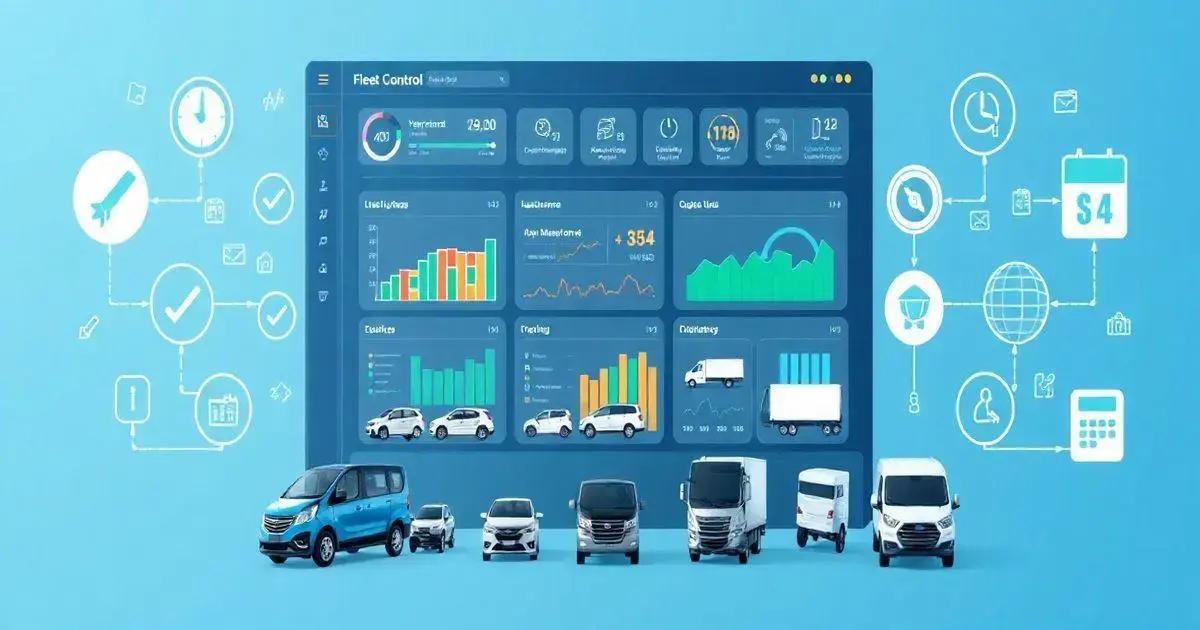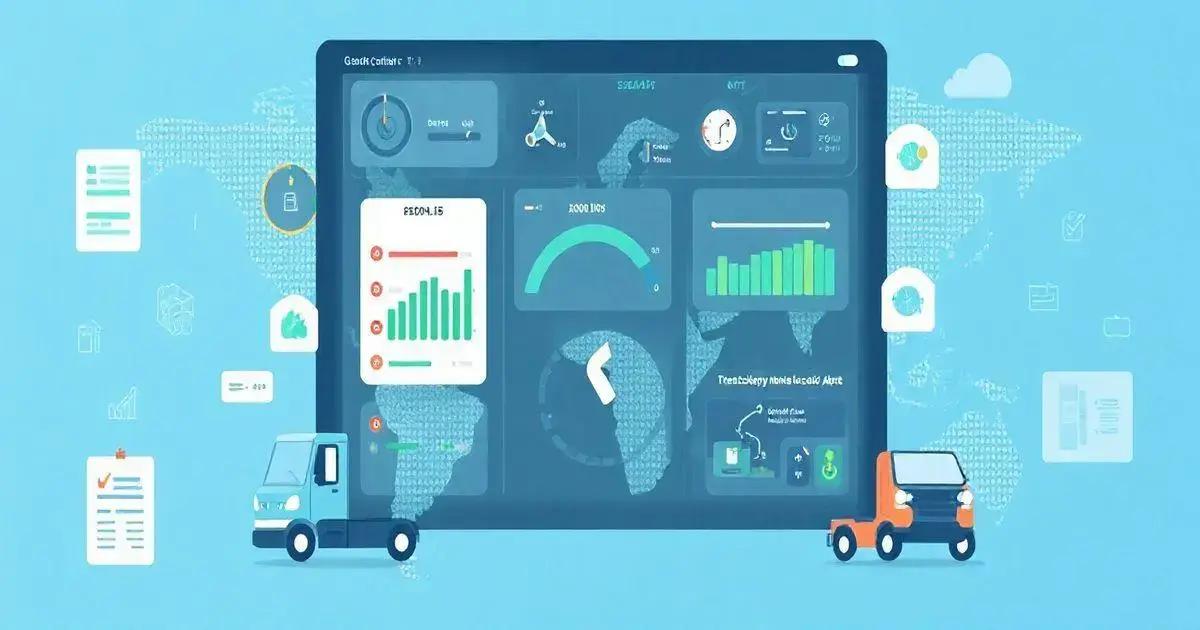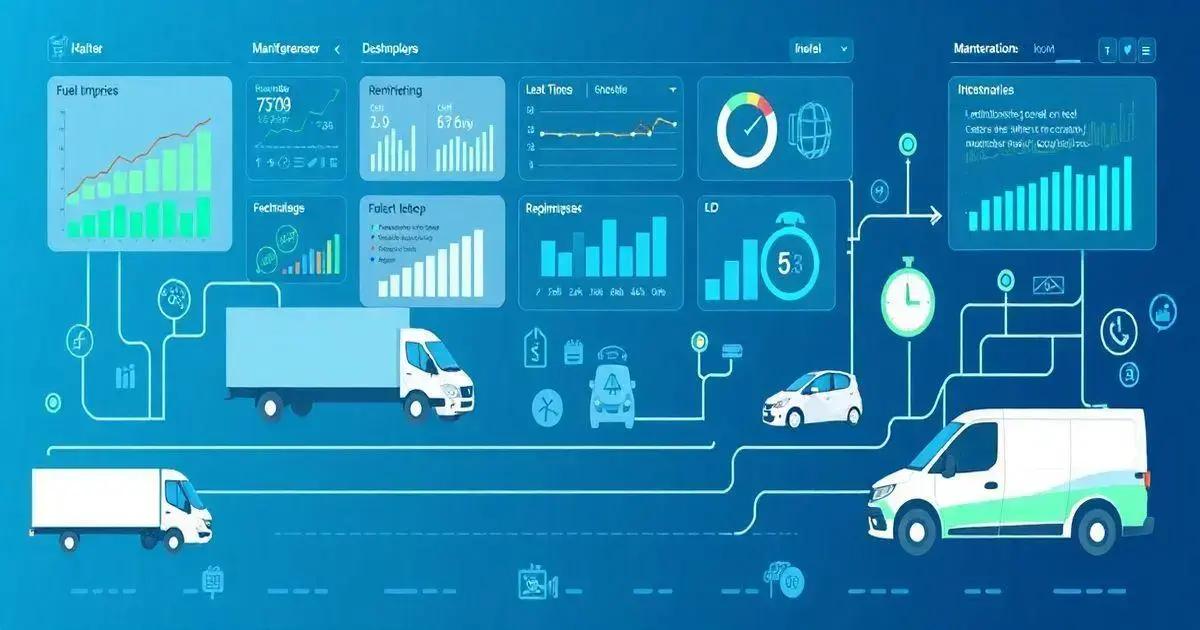7 Key Features of Fleet Control Worksheet 7.0 Leave a comment
The Fleet Control Worksheet 7.0 is a powerful fleet management tool that provides features for tracking vehicle performance, managing driver and vehicle registrations, and handling essential documents. It includes travel control for monitoring cargo and expenses, tire control for safety and performance, and maintenance insights for cost management and preventive scheduling, ultimately helping fleet managers streamline operations and achieve cost savings.
The Fleet Control Worksheet 7.0 is designed to streamline your fleet management tasks. With its numerous features, this worksheet can help you keep track of your vehicle data efficiently. Whether you’re managing fuel consumption or scheduling maintenance, this template caters to all your needs.
Initial Dashboards Overview
The Initial Dashboards in the Fleet Control Worksheet 7.0 provide a comprehensive overview of your fleet’s performance metrics. These dashboards are designed to deliver key insights at a glance, helping you make informed decisions quickly. Here’s what you can expect:
1. KM by Driver: This metric tracks the total kilometers driven by each driver, allowing you to monitor performance and plan better routes.
2. KM per Vehicle: Analyze the distance covered by each vehicle, which can help identify underutilized resources and optimize fleet deployment.
3. KM per Liter: This feature enables you to evaluate fuel efficiency. By tracking kilometers driven against fuel consumption, you can pinpoint areas for improvement in fuel management.
4. KM per Trip: Understanding the kilometers driven per trip can assist in refining your scheduling and routing strategies for better efficiency.
5. Average Consumption per Vehicle: Monitor and compare average fuel consumption across vehicles to detect anomalies and optimize fuel usage.
6. Average Consumption per Driver: This dashboard provides insight into each driver’s fuel consumption patterns, enabling targeted training or incentives for efficient driving practices.
7. Total General, Preventive, and Corrective Maintenance: Keep track of all maintenance activities, including scheduled and unscheduled repairs, to ensure all vehicles are operating at peak performance.
8. Maintenance Cost Average: Assess the average costs associated with maintaining your fleet, providing valuable data for budgeting and forecasting.
9. Total Cost of Mechanical and Electrical Maintenance: This feature helps you understand the financial impact of mechanical and electrical repairs on your overall budget.
10. Total Tire Maintenance Cost: Keep an eye on the expenses related to tire replacement and upkeep, which are crucial for vehicle safety and performance.
11. Total Lubricant Cost: This metric tracks lubricant expenses, ensuring you’re aware of all costs associated with keeping your fleet running smoothly.
12. Average Cost of Mechanical and Electrical Maintenance: By analyzing average costs, you can identify trends and potential areas for cost reduction.
13. Average Tire Maintenance Cost: Similar to above, this helps in budgeting for tire-related expenses, allowing for more accurate financial planning.
14. Average Cost with Lubricants: Understanding lubricant costs enables you to manage expenses related to vehicle maintenance more effectively.
15. Vehicles in Transit: This overview helps you keep track of which vehicles are currently on the road, aiding in resource allocation and scheduling.
16. Tires in Transit: Monitor tire usage for vehicles that are currently operating, ensuring timely replacements when necessary.
17. Delayed Vehicle Documents: This feature keeps you informed about any documentation that is overdue, which is essential for compliance and legal purposes.
18. Delayed Driver Documents: Similar to vehicle documents, track the status of driver documentation to avoid potential legal issues.
19. Delayed Preventive Maintenance: Identify any overdue maintenance tasks to ensure all vehicles are serviced on time, reducing the risk of breakdowns.
20. Total Cost Versus Shipping: Analyze costs in relation to shipping activities to assess the economic efficiency of your operations.
21. Fuel, Maintenance, and Other Costs: This comprehensive view allows you to balance operational costs with income generated from your fleet activities.
With these dashboards, the Fleet Control Worksheet 7.0 equips fleet managers with actionable insights that are crucial for maintaining operational efficiency and controlling costs. Proper usage of these features can significantly improve your fleet’s performance and reliability.

Registration Features
The Registration Features of the Fleet Control Worksheet 7.0 are designed to ensure that all critical information regarding your fleet is accurately documented and easily accessible. This helps in maintaining a well-organized fleet management system. Here are the key registration features:
Driver Registration: This feature allows you to capture essential details about each driver, including their names, contact information, license numbers, and any certifications they may hold. Keeping a comprehensive driver record is crucial for compliance and effective communication.
Vehicle Type Registration: Documenting various types of vehicles within your fleet helps in categorizing them based on functionality, size, and purpose. This can be beneficial for scheduling maintenance, managing costs, and optimizing routes based on vehicle capabilities.
Mechanical and Electrical Services Registry: This feature enables you to track all mechanical and electrical services performed on each vehicle. By maintaining a detailed history of services, you can anticipate future maintenance needs and ensure timely repairs.
Tree Service Registration: If your fleet includes vehicles that specifically cater to tree services, this registration allows you to maintain detailed records of operations, equipment used, and specific project details. This helps in analyzing performance and planning future projects effectively.
Lubricant Services Register: Track the types and quantities of lubricants used for each vehicle, which is essential for optimal performance and longevity. Understanding lubricant usage can help you budget better and make informed decisions about maintenance routines.
Register of Workshops and Suppliers: Keeping a list of trusted workshops and suppliers ensures that you have reliable sources for repairs and parts. This feature allows fleet managers to quickly access contact information and service history, facilitating efficient communication and service requests.
Expenditure Type Register: Document different types of expenditures related to your fleet, including fuel, maintenance, repairs, and unexpected costs. This comprehensive register helps in creating thorough budgets and improving financial oversight.
Refueling Station Registration: Keeping track of refueling stations used by your fleet helps in managing fuel costs and understanding consumption patterns. This information can aid in negotiating better fuel prices and identifying efficient fueling routes.
Fuel Type Register: This feature allows you to classify the types of fuel each vehicle uses, making it easier to manage fuel purchases and ensure compatibility. This is particularly useful for fleets with mixed fuel systems.
Utilizing these registration features in the Fleet Control Worksheet 7.0 fosters a structured approach to fleet management. By ensuring all relevant information is recorded and easily retrievable, managers can optimize operations, enhance compliance, and drive efficiency across their fleets.
Document Management Essentials
The Document Management Essentials feature of the Fleet Control Worksheet 7.0 is designed to help fleet managers keep track of all necessary documents related to their vehicles and drivers. This essential functionality ensures that compliance and operational efficiency are maintained. Here’s an overview of what this feature encompasses:
Driver Document Control: This feature allows you to manage and monitor all documents related to each driver, including licenses, certifications, and training records. By keeping these documents up-to-date, you can ensure that all drivers are qualified and legally allowed to operate the vehicles.
Vehicle Document Control: Similar to driver documents, this function helps keep track of important vehicle documentation, such as registration papers, insurance documents, and inspections. Having these documents readily available ensures compliance with regulations and helps avoid legal issues.
By implementing effective document management practices using the Fleet Control Worksheet 7.0, fleet managers can streamline operations, reduce the risk of penalties, and maintain a well-organized fleet documentation system. This feature ultimately contributes to better oversight and control of fleet-related activities.

Travel Control Capabilities
The Travel Control Capabilities of the Fleet Control Worksheet 7.0 are designed to provide fleet managers with the tools necessary to efficiently oversee and manage all travel-related activities. This feature is crucial for optimizing routes, reducing costs, and ensuring that all trips are properly documented. Here’s a breakdown of what you can expect from this functionality:
Cargo Control Linked to Trips: This allows you to manage and track the cargo associated with each trip. By documenting the type and amount of cargo being transported, you can ensure proper allocation and minimize losses due to mismanagement.
Vehicle Control: Keep track of which vehicles are assigned to specific trips. This feature helps in optimizing vehicle usage, ensuring that the right vehicle is being used for the right task while maintaining accurate records for maintenance and fuel consumption.
Driver Control: Monitor which drivers are assigned to each trip. This helps in managing work schedules and ensuring that drivers are not overworked, maintaining compliance with driving regulations.
Supply Control: This capability allows for the management of supplies needed during trips. Keeping track of supplies ensures that drivers have everything they need for each journey, enhancing efficiency and reducing the risk of delays due to missing resources.
Control of All Travel Expenses: Documenting all expenses related to travel—such as fuel costs, tolls, and lodging—enables fleet managers to evaluate the overall cost-effectiveness of each trip. This information is vital for budgeting and financial planning.
By leveraging the Travel Control Capabilities in the Fleet Control Worksheet 7.0, fleet managers can enhance operational efficiency, maintain accurate records, and ultimately drive down costs while ensuring that all travel activities are executed smoothly.
Tire Control Mechanisms
The Tire Control Mechanisms in the Fleet Control Worksheet 7.0 are essential for managing the maintenance and performance of tires across your fleet. Proper tire management not only ensures safety but also enhances fuel efficiency and extends the lifespan of your vehicles. Here’s what this feature includes:
1. Identification for Each Tire: This feature allows you to assign a unique identifier to each tire within your fleet. Tracking tires individually helps in monitoring their usage, maintenance schedules, and performance metrics.
2. Tire Change Schedule by KM: Set up a tire change schedule based on the kilometers driven. This proactive approach helps ensure that tires are replaced before they wear out, which is critical for safety and performance.
3. Signal of How Much KM is Left to Change the Tire: This mechanism provides alerts regarding the remaining distance before a tire should be replaced. By predicting when a tire change is necessary, you can plan maintenance more effectively and avoid unexpected breakdowns.
4. Status per Action: Manage the status of each tire based on actions taken—such as allocation to a vehicle, removal from a vehicle, scrapping, or scheduled maintenance. This feature gives fleet managers a clear overview of the current status of all tires in the fleet.
Implementing these Tire Control Mechanisms in the Fleet Control Worksheet 7.0 ensures that your fleet operates safely and efficiently, reducing the chances of accidents due to tire failure and optimizing overall maintenance costs.

Maintenance Control Insights
The Maintenance Control Insights feature within the Fleet Control Worksheet 7.0 provides fleet managers with critical information to oversee and manage vehicle maintenance effectively. This functionality is essential for ensuring all vehicles remain in optimal working condition, ultimately extending their lifespan and improving safety. Here’s a closer look at what this feature encompasses:
1. Corrective and Preventive Maintenance Type: This feature categorizes maintenance tasks into corrective (repairs needed after a breakdown) and preventive (planned maintenance to avoid issues). By tracking both types, fleet managers can balance immediate repairs with scheduled upkeep.
2. Maintenance by Vehicle: Monitor and document all maintenance activities performed on each vehicle. This includes oil changes, tire rotations, brake checks, and more. Keeping detailed records helps with compliance and aids in future maintenance planning.
3. Maintenance by Mechanical and Electrical Type, Tire, and Lubricants: This insight allows managers to analyze maintenance tasks based on specific categories. By understanding which types of maintenance are most frequent or costly, you can identify trends and streamline operations.
4. Maintenance Cost: Track the costs associated with all maintenance tasks. This information is vital for budgeting and can help identify areas where savings can be achieved, such as negotiating better rates with service providers.
5. Preventive Maintenance Schedule: Establish a schedule for preventive maintenance tasks to ensure that they are completed regularly. This proactive approach reduces the likelihood of unexpected breakdowns and extends the life of vehicles.
6. Preventive Maintenance Signal: This feature alerts fleet managers when preventive maintenance tasks are due or overdue. Timely reminders help maintain compliance with manufacturer recommendations and minimize the risk of mechanical failures.
7. Status by: Monitor the status of maintenance tasks as scheduled, accomplished, or delayed. This allows managers to keep track of ongoing maintenance activities and identify any bottlenecks in the process.
By utilizing the Maintenance Control Insights in the Fleet Control Worksheet 7.0, fleet managers can enhance the reliability and safety of their fleet, reduce costs associated with reactive maintenance, and ensure that all vehicles are operating at peak performance.
Conclusion
In conclusion, the Fleet Control Worksheet 7.0 offers a comprehensive suite of features designed to streamline fleet management effectively.
From the insightful dashboards that provide key performance metrics to the robust registration and document management capabilities, this tool equips fleet managers with the necessary resources to optimize operations and enhance efficiency.
With advanced travel control capabilities, tire management mechanisms, and detailed maintenance control insights, managing your fleet becomes not only easier but also far more effective.
By leveraging these features, fleet managers can ensure their vehicles are well-maintained, compliant with regulations, and operating at their highest potential.
Investing in the Fleet Control Worksheet 7.0 is a step toward more organized and efficient fleet management, paving the way for improved performance and cost savings in the long run.
FAQ – Frequently Asked Questions about Fleet Control Worksheet 7.0
What features does the Fleet Control Worksheet 7.0 include?
The Fleet Control Worksheet 7.0 includes features like initial dashboards, registration of drivers and vehicles, travel control capabilities, tire management, and maintenance control insights.
How does the tire control mechanism work?
The tire control mechanism allows you to track individual tires, schedule replacements based on kilometers driven, and monitor the status of each tire to ensure optimal performance.
Can I track maintenance costs with the worksheet?
Yes, you can track all maintenance costs associated with each vehicle, helping you manage your fleet’s budget effectively.
Is it possible to monitor driver documentation?
Absolutely! The worksheet helps you manage and track all essential documentation related to drivers, ensuring compliance and legal operation.
How does the travel control feature help in fleet management?
The travel control feature allows you to manage cargo, monitor vehicle assignments, track expenses, and ensure all trips are efficiently managed.
Is the Fleet Control Worksheet 7.0 suitable for all types of fleets?
Yes, the worksheet is versatile and can be used for various types of fleets, including logistics, delivery services, and construction vehicles.

